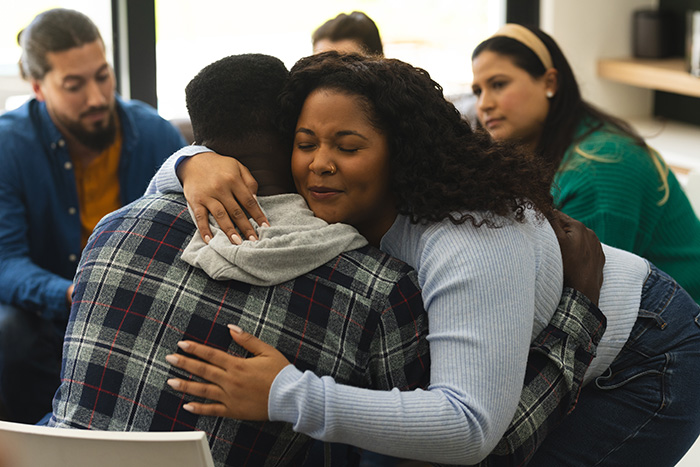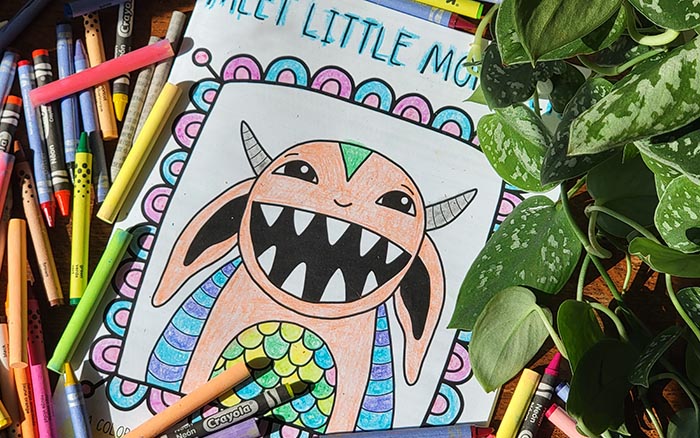Youth and Young Adult Resources
More Support for the Childhood, Adolescent, and Young Adulthood Phases
On this page, you will find additional information intended to help provide young people, educators, parents, and caregivers with the resources they need.
From a free downloadable coloring and activity book to a teen mental heath education presentation, to a guide for navigating college with a mental health condition, this page has resources for all young people.
This page also contains handy information for parents, caregivers, and educators, like a one-pager on how to start a conversation about mental health and an example week of wellness activities that can be used at home.

NAMI TraumaInSight
For youth-serving professionals who want to support young people who are struggling with trauma and challenging emotions.

Find local support
Connect with a NAMI chapter near you
Select your state to find a local NAMI affiliate. The page will redirect to the affiliate's page when a state is selected.

In need of help or support?
NAMI has a helpline specifically for teens and young adults. Get immediate support by calling, texting or emailing.
For Young People
Kids

Meet Little Monster Coloring & Activity Book
Meet Little Monster is a mental health coloring and activity book that provides children with a tool for helping express and explore their feelings in a fun, creative, and empowering way. Available for download at no-cost in multiple languages.
Teens and Young Adults
Commitment Planner—English
A resource to help students balance their school, work, and personal time to help their mental well-being!
Planificador de compromisos—Español
¡Un recurso para ayudar a los estudiantes a equilibrar su tiempo escolar, laboral y personal para contribuir a su bienestar mental!
Finding A Trusted Adult—English
Use this guide to help you choose someone to confide in about your mental health.
Encontrar un Adulto de Confianza—Español
Utilice esta guía para ayudarle a elegir a alguien en quien confiarle su salud mental.
Getting the Right Start—English
A one-pager that makes taking the first steps to asking for help less overwhelming.
Cómo Empezar Bien—Español
Una página que hace que los primeros pasos para pedir ayuda sean menos abrumadores.
How to Help a Friend
A one-pager that gives suggestions on how to support a friend struggling with a mental health condition.
Cómo Empezar Bien—Español
Un documento de una página que ofrece sugerencias sobre cómo apoyar a un amigo que lucha con un problema de salud mental.
How Young Adults Can Seek Help
A video on where and how you can find the help and support you need for a mental health condition.
How Teens Can Ask for Help
A video on who to reach out to and ways to put your thoughts and feelings into words to receive help for a mental health condition.
NAMI On Campus At-A-Glance
NAMI On Campus clubs are student-led, student-run mental health clubs for colleges and high schools.
NAMI en el Campus de un Vistazo—Español
Los clubes NAMI On Campus son clubes de salud mental dirigidos y dirigidos por estudiantes para universidades y escuelas secundarias.
NAMI Say It Out Loud
Created by young people for young people, NAMI Say It Out Loud is a free online card game that will bring you closer to your friends through conversation prompts about life, relationships, and mental health.
NAMI Teen & Young Adult Resource Directory
If you or someone you know are in need, use this directory as a guide to help navigate through your mental health journey.
Teen and Young Adult Mental Health Graphics
A set of social media graphics to start a conversation with your community about mental health check-ins, mental health game plans and our four-day gratitude challenge.
Time Management for Students
Use these tips to balance your school, work and personal time to help your mental well-being!
College Students
Language matters
A one-pager that helps individuals understand the importance of words when talking about mental health conditions and suicide.
Making A Mental Health Plan For College Students
In this video, learn how to prepare for a mental health emergency, including how to safely share medical information with someone you trust.
Mental Health College Guide
A one stop online resource to help young adults navigate the many situations encountered when in this new and exciting environment
Positive Coping Skills
In this video, learn what positive coping skills are and how to develop a mental health toolkit so that we don’t fall into negative coping strategies.
Setting Boundaries Guide—English
This resource covers different types of boundaries, how to set them, and ways to communicate them.
Guía para establecer límites—Español
Este recurso cubre diferentes tipos de límites, cómo establecerlos y formas de comunicarlos.
Social Media: Helpful Tips—English
Learn how to engage with social media safely and protect your mental health.
Redes Sociales: Consejos Útiles—Español
Aprenda a interactuar con las redes sociales de forma segura y a proteger su salud mental.
External Resources
Digital Shareables on Child and Adolescent Mental Health
From the National Institute of Mental Health (NIMH).
Quality Time in No Time: Quick and Simple Ways to Make Family Time More Meaningful
From Alliance for a Healthier Generation in collaboration with Blue Star Families.
Ways to Keep Active
From Alliance for a Healthier Generation, in collaboration with President’s Council on Sports, Fitness & Nutrition, GoNoodle®️, and Griffin Middle School.
How to Foster Self Awareness When Challenging Emotions Arise
From Alliance for a Healthier Generation, in collaboration with AAPI Youth Rising and Act to Change.
For Educators
Classroom Mental Health Contract
An activity guide to help students develop an understanding of mental health and identify supports available for them inside the classroom and at school.
Contrato de Salud Mental en el Aula—Español
Una guía de actividades para ayudar a los estudiantes a desarrollar una comprensión de la salud mental e identificar los apoyos disponibles para ellos dentro del aula y en la escuela.
Five Questions for School Staff to Ask When Preparing for an Active Shooter Drill
Cinco Preguntas Que el Personal Escolar Debe Hacer al Prepararse Para un Simulacro de Tirador Activo—Español
Language Matters
A one-pager that helps individuals understand the importance of words when talking about mental health conditions and suicide.
Mental Wellness Moments for Educators
An activity guide for educators to incorporate daily wellness activities in the classroom to enhance the emotional well-being of their students.
Momentos de Bienestar Mental Para Educadores—Español
Una guía de actividades para que los educadores incorporen actividades diarias de bienestar en el aula para mejorar el bienestar emocional de sus estudiantes.
Mindfulness Activities
Often, in school, students can find it hard to focus or can be impacted by events around them. You can use these exercises to bring students back into the moment.
Actividades de Atención Plena—Español
A menudo, en la escuela, a los estudiantes les cuesta concentrarse o se ven afectados por lo que sucede a su alrededor. Puedes usar estos ejercicios para que recuperen la concentración.
NAMI Ending the Silence
An engaging presentation that helps middle and high school aged youth learn about the warning signs of mental health conditions and what steps to take.
NAMI TraumaInSight
NAMI’s first trauma awareness training, NAMI TraumaInSight is available for all youth-serving professionals. This course is completely free, self-paced, and available to the public.
School Mental Health Resource Poster—Color
Teachers can help students access vital mental health resources easily and confidentially with this convenient poster.
School Mental Health Resource Poster—B&W
Teachers can help students access vital mental health resources easily and confidentially with this convenient poster.
Supporting Back to School Wellness
A one-pager with a few tips for teachers on how to make students’ transition back to the classroom a little bit easier during these uncertain times.
The Three C’s Educators
A one-pager with tips for educators on supporting their students’ emotional and mental well-being during the transition back to school and throughout the school year!
Los Educadores de las Tres C—Español
¡Una página con consejos para educadores sobre cómo apoyar el bienestar emocional y mental de sus estudiantes durante la transición de regreso a la escuela y durante todo el año escolar!
Three Keys for a Successful Back to School Transition
Resources for educators to create a safe and supportive classroom.
Tres Claves Para una Transición Exitosa de Regreso a Clases—Español
Recursos para que los educadores creen un aula segura y de apoyo.
For Parents and Caregivers
10 Questions on a Tuesday
An activity guide for parents and guardians to discuss mental health and well-being with their children in the home and develop supportive practical strategies.
10 Preguntas de un Martes—Español
Una guía de actividades para que los padres y tutores hablen sobre la salud mental y el bienestar con sus hijos en el hogar y desarrollen estrategias prácticas de apoyo.
Bullying Warning Signs
Bullying is a concern with children of all ages. Know how to spot the warning signs and how to start a conversation with your child about bullying.
Señales de advertencia de acoso escolar—Español
El acoso escolar es una preocupación para niños de todas las edades. Aprenda a identificar las señales de alerta y a iniciar una conversación con su hijo sobre el acoso escolar.
Creating Positive Change & Back to School Mental Health Tips
A nationwide iHeartRadio special, hosted by Ryan Gorman that includes Barbara Solish, director of youth and young adult initiatives at NAMI.
Crisis and Relapse Plan
Fill out this template to help your family and support team in the event of a crisis or relapse.
Plan de Crisis y Recaída—Español
Complete esta plantilla para ayudar a su familia y equipo de apoyo en caso de una crisis o recaída.
Finding Mental Health Care for Your Child
A video that describes what to do and where to go for help when your child shows symptom of a mental health condition.
How to be a Trusted Adult
An activity guide for parents and caregivers to explain who is a “trusted adult” and tips on how to become one.
Cómo Ser un Adulto de Confianza—Español
Una guía de actividades para padres y cuidadores para explicar quién es un “adulto de confianza” y consejos sobre cómo convertirse en uno.
Language Matters
A one-pager that helps individuals understand the importance of words when talking about mental health conditions and suicide.
NAMI Basics and Basics OnDemand
A free education program for parents, caregivers, and other family who provide care for youth (ages 22 and younger) who are experiencing mental health symptoms.
Suicide Warning Signs—English
Learn the warning signs, learn how to start a conversation, and know what to do in a mental health crisis.
Señales de advertencia de suicidio—Español
Aprenda las señales de advertencia, aprenda cómo iniciar una conversación y sepa qué hacer en una crisis de salud mental.
The Three C’s for Parents and Guardians—English
A one-pager with tips for parents on supporting their children’s emotional and mental well-being during the challenging transition back to the classroom and throughout the school year!
Las tres C para padres y tutores—Español
¡Una página con consejos para padres sobre cómo apoyar el bienestar emocional y mental de sus hijos durante la desafiante transición de regreso al aula y durante todo el año escolar!
A Week of Wellness—English
An activity guide for parents and caregivers to incorporate daily wellness activities at home to enhance the emotional well-being of their children.
Una Semana de Bienestar—Español
¡Una página con consejos para padres sobre cómo apoyar el bienestar emocional y mental de sus hijos durante la desafiante transición de regreso al aula y durante todo el año escolar!
A Guide for Working Caregivers During the Back to School Transition
Managing changing schedules and routines for a new school year can be overwhelming, especially when managing a mental health condition. Get tips for managing stress, dealing with change, and more from this resource.
Guía para cuidadores que trabajan durante la transición de regreso a clases
Gestionar los cambios de horarios y rutinas para un nuevo año escolar puede ser abrumador, especialmente si se trata de una afección de salud mental. Obtenga consejos para manejar el estrés, afrontar los cambios y más en este recurso.
For Child Welfare Youth, Families, and Staff
Behavior Is Communication: A Resource for Child Welfare Support Staff
El Comportamiento es Comunicación: un Recurso Para el Personal de Apoyo al Bienestar Infantil—Español
Building Peer Relationships for Youth and Young Adults in the Child Welfare System
A guide to help anyone navigating trauma feel less alone. Here’s how you can safely begin to seek community.
Construyendo relaciones entre pares para jóvenes y adultos jóvenes en el sistema de bienestar infantil—Español
Una guía para ayudar a quienes atraviesan un trauma a sentirse menos solos. Aquí te explicamos cómo puedes empezar a buscar comunidad de forma segura.
The Child Welfare System: A Guide to Trauma for Caregivers
A guide to help you reflect, re-establish and rebuild healing relationships with your child experiencing trauma as part of their experience in foster care.
El Sistema de Bienestar Infantil: Una Guía Sobre el Trauma Para Cuidadores—Español
Una guía para ayudarle a reflexionar, restablecer y reconstruir relaciones sanadoras con su hijo que experimenta un trauma como parte de su experiencia en acogida.
Statistics and Research
2020 Mental Health by the Numbers
A one-pager with data on the effects of the COVID-19 pandemic on youth and young adult.
New CDC data illuminate youth mental health threats during the COVID-19 pandemic
CDC’s first nationally representative survey of high school students during the pandemic can inform effective programs.
Poll of Teen Mental Health from Teens Themselves (2022)
A poll conducted by Ipsos on behalf of NAMI
Poll of Parents Amid the COVID-19 Pandemic (2021)
A poll conducted by Ipsos on behalf of NAMI finds that an overwhelming number of parents support mental health education in schools and “mental health days” for their children.
Treatment For Suicidal Ideation, Self-Harm, And Suicide Attempts Among Youth
Provides interventions to treat for suicidal ideation, self-harm, and suicide attempts among youth. It provides research on implementation and examples of the ways that these recommendations can be implemented.
Youth Risk Behavior Survey: Data Summary and Trends Report
Provides the most recent surveillance data on health behaviors and experiences among high school students in the US
Blogs and Videos
College Mental Health Blogs
Blog posts meant to support college students.
Teen Mental Health Blogs
Blog posts meant to support Teens.
Notalone Conversation: Heading Back to School
A student, parent and teacher discuss heading back to school after a year of at-home learning.
What is PTSD?
Learn what PTSD (posttraumatic stress disorder) is, its causes, symptoms, and treatment options.

Subscribe to the NAMI Next Gen Newsletter
A youth-to-youth newsletter that connects aspiring mental health advocates with tools, information and resources.
